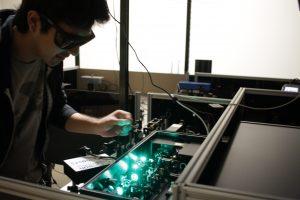Ultrafast Laser Lab
 The laboratory is equipped with a high-power, CEP stabilized Yb:KGW amplifier (Light Conversion PHAROS) with integrated near-infrared optical parametric amplifier (OPA, Light Conversion I-OPA-F-CEP), and an external mid-infared OPA (Light Conversion ORPHEUS-ONE). The amplifier supplies 20 W of average power at a wavelength of 1.03 µm and repetition rates between 50-200 kHz (100-400 µJ/pulse). The CEP of the amplified laser pulses is actively stabilized. We also have conducted experiments using laser sources in the iFAST (Institute for the Frontiers of Attosecond Science and Technology) Laboratory and the Laser Plasma Laboratory.
The laboratory is equipped with a high-power, CEP stabilized Yb:KGW amplifier (Light Conversion PHAROS) with integrated near-infrared optical parametric amplifier (OPA, Light Conversion I-OPA-F-CEP), and an external mid-infared OPA (Light Conversion ORPHEUS-ONE). The amplifier supplies 20 W of average power at a wavelength of 1.03 µm and repetition rates between 50-200 kHz (100-400 µJ/pulse). The CEP of the amplified laser pulses is actively stabilized. We also have conducted experiments using laser sources in the iFAST (Institute for the Frontiers of Attosecond Science and Technology) Laboratory and the Laser Plasma Laboratory.
High-Order Harmonic Spectroscopy in Solids
 We apply intense mid-infrared laser pulses to generate high-order harmonics from solids. By using long-wavelength driving lasers, we are able to access the Keldysh tunneling limit in semiconductors and insulators, wherein the excitation of electrons and their subsequent motion is governed by the instantaneous field strength. The dynamics of charge carriers, including electron interactions in strongly-correlated materials, are encoded in the spectrum and phase of the emitted harmonics. Our work in high-order harmonic spectroscopy in solids focuses in three areas: (1) Generating isolated attosecond optical and UV pulses, (2) determining the role of structural and electronic symmetries in high-order harmonic generation, and (3) characterizing the mechanisms of high-order harmonic generation in different regimes, and the role played by propagation of the intense fields in the bulk crystal.
We apply intense mid-infrared laser pulses to generate high-order harmonics from solids. By using long-wavelength driving lasers, we are able to access the Keldysh tunneling limit in semiconductors and insulators, wherein the excitation of electrons and their subsequent motion is governed by the instantaneous field strength. The dynamics of charge carriers, including electron interactions in strongly-correlated materials, are encoded in the spectrum and phase of the emitted harmonics. Our work in high-order harmonic spectroscopy in solids focuses in three areas: (1) Generating isolated attosecond optical and UV pulses, (2) determining the role of structural and electronic symmetries in high-order harmonic generation, and (3) characterizing the mechanisms of high-order harmonic generation in different regimes, and the role played by propagation of the intense fields in the bulk crystal.
Time- and Angle-Resolved Photoemission Spectroscopy in Novel Materials
 We apply unique few-cycle light sources and laser-generated high-order harmonics in pump-probe measurements of novel materials using angle-resolved photoemission spectroscopy, in collaboration with Prof. Madhab Neupane. We aim to characterize novel topological and quantum materials, to probe carrier dynamics in these materials on timescales ranging from ~10 as to ~1 ps, and to induce new transient topological and quantum phases of matter through interactions with intense laser fields.
We apply unique few-cycle light sources and laser-generated high-order harmonics in pump-probe measurements of novel materials using angle-resolved photoemission spectroscopy, in collaboration with Prof. Madhab Neupane. We aim to characterize novel topological and quantum materials, to probe carrier dynamics in these materials on timescales ranging from ~10 as to ~1 ps, and to induce new transient topological and quantum phases of matter through interactions with intense laser fields.
Attosecond Spectroscopy
 By compressing the output of our Yb:KGW laser amplifier to single-cycle pulse durations, while maintaining stable carrier-envelope phase, we aim to generate isolated attosecond XUV pulses from gas and solid-phase targets. We will apply these pulses for attosecond time-resolved spectroscopy of strong-field laser-driven electron dynamics in atomic, molecular, and solid-state systems.
By compressing the output of our Yb:KGW laser amplifier to single-cycle pulse durations, while maintaining stable carrier-envelope phase, we aim to generate isolated attosecond XUV pulses from gas and solid-phase targets. We will apply these pulses for attosecond time-resolved spectroscopy of strong-field laser-driven electron dynamics in atomic, molecular, and solid-state systems.
